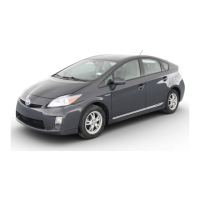Do you have a question about the Toyota PRIUS 2017 and is the answer not in the manual?
Covers safe driving posture, seat belt usage, child restraint systems, and exhaust gas precautions.
Explains hybrid system features, operation, and precautions for efficient and safe driving.
Information on the immobilizer system and theft prevention.
Explains the meaning and function of various warning and indicator lights on the instrument panel.
Guides on reading vehicle speed, fuel level, hybrid system status, and trip meters.
Explains how to navigate and use the multi-information display for various driving data.
Information on how to read the energy monitor and consumption screens for driving efficiency.
Details on the electronic keys, mechanical keys, and wireless remote control functions.
Procedures for operating vehicle doors, locks, and key systems.
Instructions for adjusting front and rear seats and head restraints for comfort and safety.
Guidance on adjusting the steering wheel and rear-view mirrors for optimal driving posture and visibility.
How to operate power windows, including one-touch and jam protection features.
Essential checks before driving, including vehicle load limits, trailer towing, and dinghy towing.
Step-by-step guide for starting, stopping, and operating the hybrid system and shift lever.
Instructions for using headlights, fog lights, wipers, and washers for visibility and signaling.
Precautions and steps for opening the fuel tank cap and refueling the vehicle safely.
Explains cruise control, dynamic radar cruise control, LDA, rear view monitor, and PCS systems.
Advice for economical driving, checking tire pressure, and winter driving precautions.
Fundamental operations of the audio system, including basic controls and connections.
How to configure system settings like language, units, sound, display, and voice commands.
Guidance on selecting audio sources, using the list screen, and optimizing multimedia system usage.
Instructions for tuning radio stations, using preset stations, and scanning for signals.
Information on playing audio CDs and digital media files, including compatibility and error messages.
How to connect and use iPod, USB memory devices, and portable audio players via AUX.
Steps for registering and connecting Bluetooth® devices for audio and phone functions.
How to listen to audio from a connected Bluetooth® device, including status display.
Using the hands-free phone system for calls, messages, contacts, and troubleshooting.
How to operate various vehicle functions using voice commands and the mobile assistant.
Guides on operating automatic air conditioning, airflow modes, defoggers, and seat heaters.
Details on operating front, rear, and personal interior lights, including illuminated entry system.
Information on using glove boxes, console box, cup holders, and luggage compartment features.
Instructions for sun visors, vanity mirrors, power outlets, assist grips, and garage door opener.
Guidelines for cleaning and protecting the vehicle's exterior and interior surfaces.
Overview of maintenance requirements, general checks, and scheduled services.
Step-by-step instructions for common maintenance tasks like checking fluids, tires, fuses, and bulbs.
Critical information regarding essential precautions and steps for vehicle emergencies.
Detailed guidance on handling common emergency situations like flat tires, dead batteries, or system malfunctions.
Technical data including dimensions, engine, fuel, electrical system, and tire specifications.
How to personalize vehicle settings like door locks, lights, and instrument cluster displays.
Procedures for initializing systems like maintenance reminders and tire pressure warnings after service.
Information for U.S. owners on how to report vehicle safety defects to NHTSA.
Covers safe driving posture, seat belt usage, child restraint systems, and exhaust gas precautions.
Explains hybrid system features, operation, and precautions for efficient and safe driving.
Information on the immobilizer system and theft prevention.
Explains the meaning and function of various warning and indicator lights on the instrument panel.
Guides on reading vehicle speed, fuel level, hybrid system status, and trip meters.
Explains how to navigate and use the multi-information display for various driving data.
Information on how to read the energy monitor and consumption screens for driving efficiency.
Details on the electronic keys, mechanical keys, and wireless remote control functions.
Procedures for operating vehicle doors, locks, and key systems.
Instructions for adjusting front and rear seats and head restraints for comfort and safety.
Guidance on adjusting the steering wheel and rear-view mirrors for optimal driving posture and visibility.
How to operate power windows, including one-touch and jam protection features.
Essential checks before driving, including vehicle load limits, trailer towing, and dinghy towing.
Step-by-step guide for starting, stopping, and operating the hybrid system and shift lever.
Instructions for using headlights, fog lights, wipers, and washers for visibility and signaling.
Precautions and steps for opening the fuel tank cap and refueling the vehicle safely.
Explains cruise control, dynamic radar cruise control, LDA, rear view monitor, and PCS systems.
Advice for economical driving, checking tire pressure, and winter driving precautions.
Fundamental operations of the audio system, including basic controls and connections.
How to configure system settings like language, units, sound, display, and voice commands.
Guidance on selecting audio sources, using the list screen, and optimizing multimedia system usage.
Instructions for tuning radio stations, using preset stations, and scanning for signals.
Information on playing audio CDs and digital media files, including compatibility and error messages.
How to connect and use iPod, USB memory devices, and portable audio players via AUX.
Steps for registering and connecting Bluetooth® devices for audio and phone functions.
How to listen to audio from a connected Bluetooth® device, including status display.
Using the hands-free phone system for calls, messages, contacts, and troubleshooting.
How to operate various vehicle functions using voice commands and the mobile assistant.
Guides on operating automatic air conditioning, airflow modes, defoggers, and seat heaters.
Details on operating front, rear, and personal interior lights, including illuminated entry system.
Information on using glove boxes, console box, cup holders, and luggage compartment features.
Instructions for sun visors, vanity mirrors, power outlets, assist grips, and garage door opener.
Guidelines for cleaning and protecting the vehicle's exterior and interior surfaces.
Overview of maintenance requirements, general checks, and scheduled services.
Step-by-step instructions for common maintenance tasks like checking fluids, tires, fuses, and bulbs.
Critical information regarding essential precautions and steps for vehicle emergencies.
Detailed guidance on handling common emergency situations like flat tires, dead batteries, or system malfunctions.
Technical data including dimensions, engine, fuel, electrical system, and tire specifications.
How to personalize vehicle settings like door locks, lights, and instrument cluster displays.
Procedures for initializing systems like maintenance reminders and tire pressure warnings after service.
Information for U.S. owners on how to report vehicle safety defects to NHTSA.
| Brand | Toyota |
|---|---|
| Model | PRIUS 2017 |
| Category | Automobile |
| Language | English |












